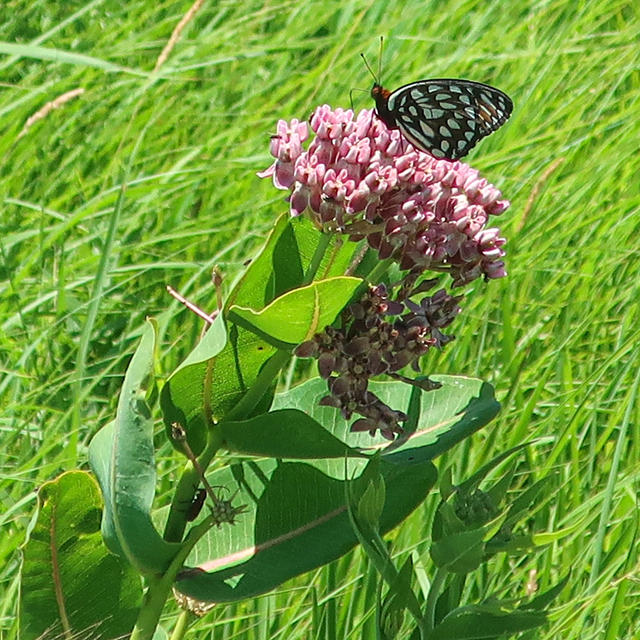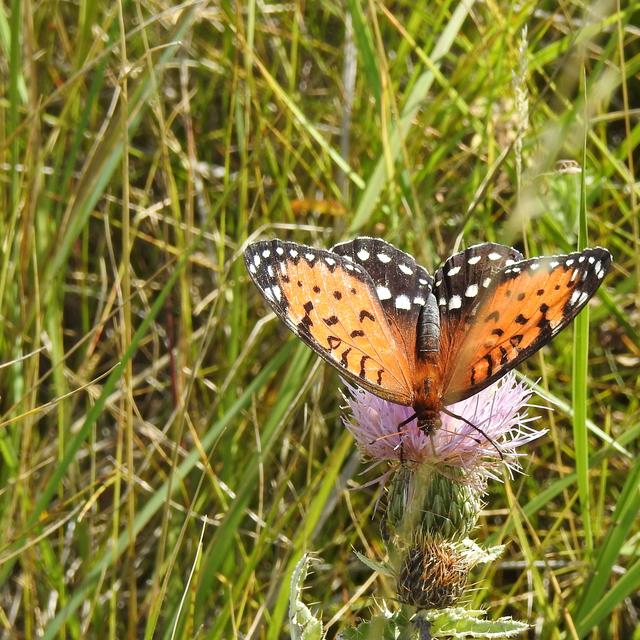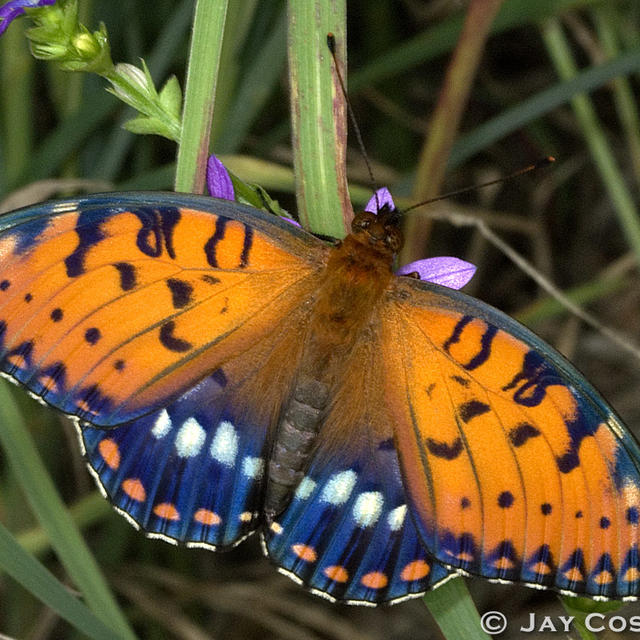Regal Fritillary
Speyeria idalia (Drury, 1773)
Family: Nymphalidae
Subfamily: Heliconiinae
Identification: Large. Upperside of forewing bright red-orange with black markings. Upperside of hindwing black with postmedian row of white spots; submarginal row of spots is orange in male and white in female.
Wing Span: 2 5/8 - 4 1/8 inches (6.7 - 10.5 cm).
Life History: Males patrol for females with a low, steady flight. Females walk through vegetation to lay single eggs on various plants, even if the host violets are not present. Most eggs are laid in August. The caterpillars hatch and overwinter unfed; in spring they eat leaves of host plants.
Flight: One brood from mid-June to mid-August.
Caterpillar Hosts: Violets including bird\'s foot violet (Viola pedata).
Adult Food: Nectar from flowers of milkweeds, thistles, red clover, and mountain mint.
Habitat: Tall-grass prairie and other open sites including damp meadows, marshes, wet fields, and mountain pastures.
Range: Tall-grass prairie remnants in Montana and North Dakota south to Colorado, Nebraska, and Oklahoma; rare or absent from former range east of the Appalachians.
Conservation: Rapidly vanishing or declining in much of its range. A species of concern for the United States Fish and Wildlife Service. All populations should be conserved.
NCGR: G3 - Very rare or local throughout its range or found locally in a restricted range (21 to 100 occurrences). (Threatened throughout its range).
Management Needs: Monitor populations and manage populations on public lands and preserves.
Comments: NULL
Get your BAMONA Gear!
Please donate!
We depend on donations to keep Butterflies and Moths of North America freely available. We want to express our gratitude to all who showed their support by making a contribution this year. You can donate to support this project at any time.
Advertise with us!
Do you have a product or service that you think would interest BAMONA users? If you would like to advertise on this website, contact us by email, or use the contact form and select the "Advertising" category.
Verified Sightings
Displaying 1 - 24 of 873 verified sightings

Observation date: Aug 19, 2024
Submitted by: bbroyles
Region: Greenwood County, Kansas, United States
Verified by: James Steen
Verified date: Aug 20, 2024

Observation date: Jul 07, 2024
Submitted by: dvollmar
Region: Wright County, Minnesota, United States
Verified by: jmgesell
Verified date: Aug 07, 2024

Observation date: Jul 05, 2024
Submitted by: Eric Hartshaw
Region: Lebanon County, Pennsylvania, United States
Verified by: davidwright
Verified date: Jul 13, 2024

Observation date: Jun 24, 2024
Submitted by: vogelbild
Region: Lee County, Illinois, United States
Verified by: rogerdowner
Verified date: Jun 29, 2024

Observation date: Jun 01, 2024
Submitted by: James Steen
Region: Harper County, Kansas, United States
Verified by: James Steen
Verified date: Jun 01, 2024

Observation date: Aug 26, 2023
Submitted by: gersonea
Region: Morton County, North Dakota, United States
Verified by: stevekohler
Verified date: Nov 24, 2023

Observation date: Jul 01, 2023
Submitted by: Eddie Wyatt
Region: Lebanon County, Pennsylvania, United States
Verified by: davidwright
Verified date: Jul 04, 2023

Observation date: Jun 11, 2023
Submitted by: Jill Haukos
Region: Pottawatomie County, Kansas, United States
Verified by: James Steen
Verified date: Jun 11, 2023

Observation date: Jun 08, 2023
Submitted by: Jill Haukos
Region: Riley County, Kansas, United States
Verified by: James Steen
Verified date: Jun 11, 2023

Observation date: Jun 24, 2022
Submitted by: WYbutterflyer1
Region: Sioux County, Nebraska, United States
Verified by: Emily Geest
Verified date: Feb 06, 2023

Observation date: Sep 09, 2022
Submitted by: Dave Rintoul
Region: Pottawatomie County, Kansas, United States
Verified by: James Steen
Verified date: Sep 09, 2022

Observation date: Jul 18, 2021
Submitted by: Ed Rothwell
Region: Newton County, Indiana, United States
Verified by: jmgesell
Verified date: Jun 21, 2022

Observation date: Jun 20, 2022
Submitted by: Jill Haukos
Region: Riley County, Kansas, United States
Verified by: James Steen
Verified date: Jun 20, 2022

Observation date: Jun 16, 2022
Submitted by: Lisa H
Region: Ottawa County, Kansas, United States
Verified by: James Steen
Verified date: Jun 17, 2022

Observation date: Jul 04, 2010
Submitted by: BarbSendelbach
Region: Lebanon County, Pennsylvania, United States
Verified by: BarbSendelbach
Verified date: Jun 09, 2022
Observation date: Jul 19, 1981
Submitted by: James Steen
Region: Reno County, Kansas, United States
Verified by: James Steen
Verified date: May 30, 2022

Observation date: Jul 12, 2021
Submitted by: L Reid
Region: Wabasha County, Minnesota, United States
Verified by: Tom Middagh
Verified date: Aug 07, 2021

Observation date: Jul 02, 2021
Submitted by: JMJaskula
Region: Newton County, Indiana, United States
Verified by: Howell_Curtis
Verified date: Jul 08, 2021

Observation date: Jun 14, 2021
Submitted by: Jill Haukos
Region: Pottawatomie County, Kansas, United States
Verified by: stomlins701
Verified date: Jun 26, 2021

Observation date: Jun 15, 2021
Submitted by: Jill Haukos
Region: Riley County, Kansas, United States
Verified by: stomlins701
Verified date: Jun 26, 2021

Observation date: Jun 17, 2021
Submitted by: Rosered
Region: Douglas County, Kansas, United States
Verified by: stomlins701
Verified date: Jun 26, 2021

Observation date: Aug 14, 2019
Submitted by: heinert
Region: Stark County, North Dakota, United States
Verified by: stevekohler
Verified date: May 10, 2021

Observation date: Jul 09, 2009
Submitted by: Joanne Ryan
Region: Otter Tail County, Minnesota, United States
Verified by: Tom Middagh
Verified date: Feb 15, 2021

Observation date: Jul 28, 2018
Submitted by: Puccini
Region: Richland County, North Dakota, United States
Verified by: stevekohler
Verified date: Feb 03, 2021
- 1 of 37
- next ›







